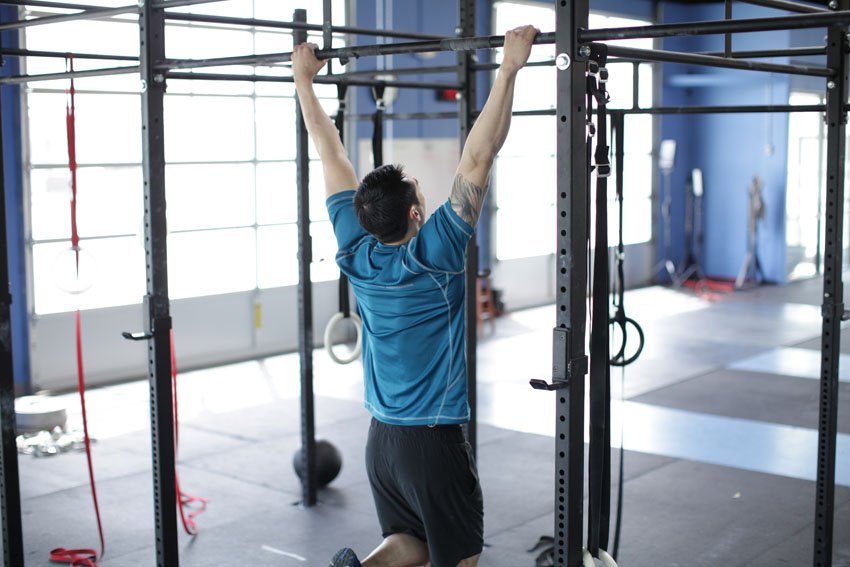Above all else, strength development depends on your ability to identify and build upon your weaknesses. While it’s obviously more fun to focus on the things you’re already good at, if you don’t spend time bringing up your weak points you’ll never achieve your maximum strength potential. In the words of Louie Simmons, “you’re only as strong as your weakest link.”
In this series I’m going to present you with an arsenal of information to help identify your weaknesses and develop an action plan to build them into strengths. In addition to addressing common technique and programming related errors, I’ll outline proven methods designed to increase your strength in the bench press, chin-up, squat, and deadlift.
The Chin-up
The chin-up is an extraordinary tool to use in the development of total body strength and function. To reap its countless benefits, however, it’s necessary to maintain proper form and technique throughout the entire range of motion.
Below I’ve identified some of the most commonly made errors when performing the chin-up. Afterward I expand upon these errors and outline several methods to improve chin-up performance.
3 Common Chin-up Errors
1. Neglecting the Eccentric
The eccentric (i.e. lowering) component of the chin-up is just as important as the concentric (raising) component. Unfortunately, many trainees make the mistake of making it all the way to the top only to drop down with a complete lack of control. Upon initiating the lowering phase of the chin-up, control yourself all the way down until your elbows are locked out in the bottom position. The entire lowering phase should take between 1-3 seconds.
2. Shrugging the Shoulders
During the chin-up a natural tendency for many trainees is to shrug their shoulders up towards their ears. Unfortunately, doing so places the shoulder in a vulnerable position as well as reduces involvement of the low/mid traps and rhomboids. For the best results, force your shoulders down and away from your ears throughout the entire range of motion. As Mike Robertson says, “try to place your shoulders in your back pocket.”
3. Using Momentum
Consciously or not, trainees frequently swing their legs in an attempt to gain momentum on the way up to the bar. Needless to say, this is not only improper technique but it actually reduces the effectiveness of the exercise. To keep yourself from making the same mistake, straighten your legs, wrap one foot around the other, and flex your quads and butt as tight as possible throughout the entire movement. Doing so will not only target the upper back more effectively but may significantly recruit the lower abdominals as well.
3 Methods to Improve Chin-up Performance
1. Grease the Groove
Perhaps the simplest, albeit most effective, way to improve chin-up performance is to perform them as often as possible. Popularized by Pavel Tsatsouline, the Grease the Groove (GTG) method involves performing chin-ups consistently throughout the day with the one major caveat being: never go to failure! Set up a chin-up bar/station in your bedroom doorway and do a couple reps every time you walk through. Keep the repetitions relatively low and, using this method, never go to failure.
2. Negative Repetitions
If you have trouble performing a complete chin-up, incorporating negative repetitions into your routine is a great way to improve chin-up performance while getting many of the same benefits. When performing negatives, jump up to the top portion of the chin-up and slowly lower yourself to the bottom position over a period of 3-5 seconds. Once you reach the bottom position, jump back up to the top and repeat for the prescribed number of repetitions. Generally speaking, performing anywhere between 3-5 sets of 3-6 repetitions two times per week is sufficient for the best results.
3. Pull Through Your Elbows
The chin-up is arguably the single best exercise for overall back development. Interestingly, however, many trainees report that they rarely “feel” their back working to produce the movement. While there could be numerous reasons for this, I’ve found that cueing individuals to pull through their elbows, instead of their hands, forces them to use their back more effectively. When initiating the chin-up, imagine that your hands are simply hooks and you must pull through the elbows in order pull yourself up to the top position.

Hey Jordan what is your opinion about de Hammer Pull Up?